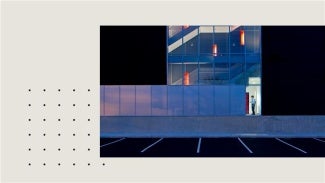
How architects are tackling data center design
A new typology in a rapid growth sector offers opportunities for design innovation.
The United States currently houses the largest number of data centers in the world – about 2,670. While these structures are physically large, spanning about the size of four football fields, their purpose is even bigger: making everything we do on the internet possible.
With permanent shifts to remote and hybrid work accelerated by the COVID-19 pandemic, the real-world space that houses and enables the digital realm is currently expanding at a more rapid pace than ever before. In 2021, Microsoft announced its intention to build 50 to 100 new data centers each year for the foreseeable future.
Chheng Lim, an associate at Chicago-based Sheehan Nagle Hartray Architects, specializes in designing these information storing and processing hubs. As she pointed out in a presentation at AIA’s Conference on Architecture 2022, this is the first time the organization is addressing this emerging building typology. Using Sheehan Nagle Hartray’s design of the Fort Worth Data Center Administration Building as a case study – winner of a Distinguished Building Award from AIA Chicago in 2020 – Lim explained how architects on data center projects are faced with a unique challenge in how they are trained to think: in terms of human-scale design. These data spaces, she explained, may not be made to accommodate humans, but they are “human by proxy” – and they represent an expanded role for architects in our new internet-led wave of industrialization.
The Fort Worth Data Center, stacked vertically, would be of comparable size to skyscrapers like Chicago’s Willis Tower. “A data building may house somewhere in the neighborhood of 50 to 150 people – but [it also] houses servers that allow millions of people all over the world to connect,” Lim said. But while iconic skyscrapers like the Willis Tower are meant to interface with the public and draw people in, data centers are what Lim calls “quiet by design” – built for privacy and security.
"Show" and "stealth"
The dual design requirements of data center administration areas – places built for humans, on a human scale – and data halls where servers are stored call for different modes of thinking. For speed of construction, as well as for reasons of security, the long repetitive modules of the data halls can easily be made of pre-cast concrete. “[They want] to be incognito in the landscape,” Lim says.
In contrast, the administration building offers something more visually stimulating for human eyes. The façade of the Fort Worth Data Center Administration Building was inspired by the IBM punch code – the original code from the 1960s that powered the computers that sent astronauts to space.
“We felt that it was a conversation,” Lim said of this design decision. “It was a nod and reference to both the history and the future of digital computing.” Holistic designs for data centers, she said, are a combination of show – for example, views to the outdoors for human workers – and “stealth,” i.e. data halls housing high volumes of servers. For the latter areas, concerns such as climate control and security are key.
Two conversations: energy and closing the digital divide
It’s true that data centers do consume a great deal of energy – as much power, in the case of the Fort Worth center, to light up 720,000 lightbulbs, or a town roughly the size of Bath, England.
“This is usually the part of the conversation where people start to freak out and think that data centers are gobbling up the world’s energy,” Lim said, “but the conversation gets a little bit more nuanced than that.” If we look at data center energy usage as a percentage of total global energy demand, she says, the amount of energy that data centers consume – considering how much information they process and relay – is 1%, according to the International Energy Agency. Their efficiency has kept pace with their exponential growth over the last several decades.
Lim says that what often gets left out when the conversation stays focused on energy is what she calls the “human aspect” of the conversation – or the inequities posed by only certain segments of the world’s population, currently about 60%, having access to the internet.
“This is not something we’re going to solve by building fewer data centers, watching one less cat video, or going on one less video conference call,” she said. “What we’re trying to plan for is for 100% of the world population to go online.” The remaining 40% is in the global south, as well as rural and underprivileged communities. What data center designers are trying to solve for is equity and access – which is something that needs to be solved to bridge the digital divide.
Lim also highlighted the fact that her firm’s data center clients have done “a great deal” of research into renewable energy. The Fort Worth project is LEED Gold certified and, Lim said, runs on 100% renewable energy.
Broadening the traditional role of the architect
“Architects, in this manner, are not just designing a building – we are also designing a design process itself,” Lim said. Because of the emerging nature of data center design, the typology is ripe for innovation. And with so many new facilities in the pipeline, and so much at stake with data being stored and transferred, it’s important for architects to advocate for good design, especially in areas of resiliency – keeping water out, making sure backup systems are planned for, and even ensuring sustainable supply chains.
Katherine Flynn is Director of Digital Content at AIA.
